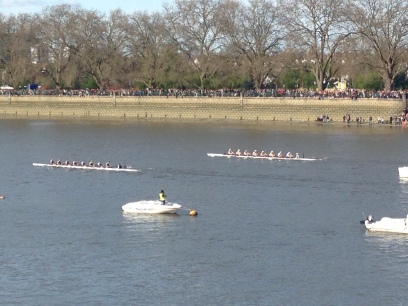 Saturday 11th April is a day that will go down in history. A day when gender equality took a small, but hugely significant step forward. A day when, as one banner put it, ‘women (were) first, at last’. A day that I didn’t think I would see for possibly decades to come. When 18 girls (not forgetting another 18 the day before) finally overcame history, prejudice and misogyny and got to do a rowing race.
Saturday 11th April is a day that will go down in history. A day when gender equality took a small, but hugely significant step forward. A day when, as one banner put it, ‘women (were) first, at last’. A day that I didn’t think I would see for possibly decades to come. When 18 girls (not forgetting another 18 the day before) finally overcame history, prejudice and misogyny and got to do a rowing race.
So what, some people will say. A private match between 2 universities. So what, others will say, it’s not like the girls didn’t row before. Both of which statements are true. In fact the girls have been rowing a boat race for 80 out of the last 88 years. Not that you’d know that if you didn’t take more than a passing interest in rowing. But this is not just 2 universities rowing, it is one of the most watched sporting events in the British calendar. It may be an anachronistic event, but it is one of those peculiarly British institutions where even those with no affiliation to either side will pick a colour and cheer for it. Where 4 or more million people will sit down on a Saturday afternoon and watch on the TV, and another possibly tens of thousands will line the River Thames to watch and cheer and drink champagne. And that, precisely, is the point. The audience and the potential to influence young girls and show them what is possible.
Young girls like one of my friends who rowed for the other side (no-one is perfect). When she was a young girl she and her family watched the boat race and she told her family that one day she would be rowing in the boat race. Don’t be silly, they replied, you’re a girl and only boys do the boat race. Luckily she’s a stubborn old fool and went on to row for Oxford for 2 years. But, perhaps this year, when a young girl announces her intention to take part in the boat race, kindly parents will look up the nearest rowing club rather than telling her she was born the wrong gender. And that is a massive step forward not only for equality, but for improving the health, confidence and body-image of girls who, as I’ve written before, tend to have worse outcomes than young boys in all these areas. They now have role models and something to aspire to.
So, nearly 100 years after women got the vote, 88 years after the first women’s boat race and 45 years after the equal pay act, the girls were finally allowed to take part. As for the green-eyed monster, I wish I could have been a part of that crew, the first to row on the same day, in the same place as the men, the first to be recognised for the athletes they are (and it’s worth noting that they most decorated Olympian to ever row in the boat race, male or female, was the Oxford women’s stroke – a double Olympic gold medallist, plus a silver for good measure) and that they train as hard as the men. Although perhaps I shouldn’t be too jealous as I, along with every other girl that has rowed with either of the women’s boat clubs, have played a part in getting to this stage, persisting in the face of adversity, and for generations before me often downright hostility, by showing that women can train and compete, and by keeping the clubs going for the next generation in the hope that things would change.
And, many years too late, they have. Hurray for that.